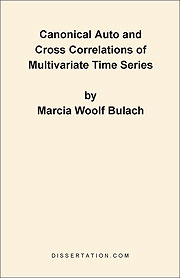LibraryPhysical Science & MathMathematics

Canonical Auto and Cross Correlations of Multivariate Time Series
| Institution: | Birkbeck College |
|---|---|
| Advisor(s): | Philip Holgate, William Derek Ray, Andris Abakuks |
| Degree: | Ph.D., Statistics |
| Year: | 1997 |
| Volume: | 415 pages |
| ISBN-10: | 1581120559 |
| ISBN-13: | 9781581120554 |
Abstract
The study of Multivariate Time Series has always been more difficult at the modeling stage than the univariate case. Identification of a suitable model, questions of stability, and the difficulties of prediction are well recognised. A variety of methods appear to be worth examining. This thesis is concerned with the proposal of an useful tool which is to apply canonical analysis to a realisation of a Multivariate Time Series and concentrates it's attention on k-variate ARMA(p,q) models. The multivariate series is partitioned into two overlapping or non-overlapping sets of different sizes. The left set is kept at lag 0 (without loss of generality) and the right set at a sequence of lags s=0,1,... . The model includes the possibility that the same subset of variables belong to the left set at lag 0 and to the right set at lag s. A technique for dimension reduction is suggested. We tried to elucidate identification and the internal structure of time-dependence at several pairs of lags as a tool for identification. As the technique suggested provide a method of investigation of patterns of interrelations between two multivariate sets or subsets of variables with a joint distribution, it is an efficient tool for use in multivariate series of economic data.
A review of the basic models of Multivariate Time Series is given and their canonical auto and cross correlation analysis is presented. In order to study the asymptotic distribution, several Monte Carlo experiments were necessary. We attempted to provide information through simulation about the distributional and other statistical properties for the canonical statistics obtained by our procedures.
New software is provided and data experience is given. The first computer program provides us with information, graphs for the canonical auto and cross correlations, test statistics for the 'useful' canonical auto and cross correlations as well as the left and right eigenvectors, left and right intraset and interset matrices of correlations, proportions of variances extracted by the canonical variates of the left and of the right sets and left and right redundancies for lags s=0,1,... .The second program gives similar calculations for the k-variate ARMA(p,q) models when the matrices of parameters and variance-covariance matrix of the error are known. The third program provides us with the mean value, minimum and maximum values, excess kurtosis, histogram and cumulative distribution for each one of the canonical auto and cross correlations at every lag s calculated from several simulations of Monte Carlo generated k-variate ARMA(p,q) models when the matrices of parameters and variance-covariance matrix of the error are given or when they are generated.
The second part of the thesis is devoted to the generalisation of the robust and practically useful univariate Holt-Winters model. We developed formula for the Multivariate Additive Holt-Winters (Seasonal and Non-Seasonal) to the point of application and its reduction to Moving Average form. New software is produced.
The link between the two main themes consists on the canonical analysis of a Multivariate Holt-Winters from its reduced MA form and reducing its dimension as well as detecting the basic linear relationships between variables, between and within several lags.
We also attempted to investigate the effect of outliers, the removal of non-stationary trends via cubic spline fitting , differencing as well as transformations such as loge (data).
